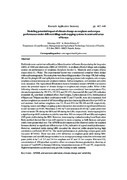| dc.description.abstract | Field trials were carried out at Kambi ya Mawe location in Eastern Kenya during the long rains
(LRS) of 2010 and short rains (SRS) of 2010/2011, to evaluate effect of tillage and cropping
system on performance of sorghum (Sorghum bicolor L. Moench) and cowpea (Vigna
unguiculata (L.) Walp). The experimental layout was a randomised complete block design
with a split arrangement. The main plots were three tillage practices (Tie-ridge-TR, Sub soilingSR and Ox plough-OP) and split plots were four cropping systems (sole sorghum, sole cowpea,
sorghum-cowpea intercrop and sorghum rotation). Surface roughness, soil moisture and yields
were measured. The Agricultural Production System Simulator model (APSIM) was used to
assess the potential impact of climate change on sorghum and cowpea yields. Effect of the
following climatic scenarios on crop performances was considered, base temperature (To),
elevated temperatures by 1oC (T1), 2oC (T2) and 3oC (T3), base rainfall (Ro) and 10% reduction
in rainfall (R1
) and their combined effect. For Cowpea, Carbon dioxide (CO2
) fertilisation at
450ppm and 700ppm and their combination with T2 and T3 and R1
were also examined. Soil
surface roughness as a result of different tillage practices had a significant effect (p< 0.05) on
soil moisture. Soil surface roughness was 72, 29 and 25% for TR, SR and OP, respectively.
Cropping season and tillage-cropping system interaction also resulted in significant difference
in soil moisture (p< 0.05). Maximum (1.96 t ha-1) and minimum (0.36 t ha-1) grain yield were
achieved under TR during the SRS and OP during the LRS, respectively. Intercropping led to
a significant (p<0.05) reduction in yield by more than 50% in cowpea (OP and SR) and sorghum
(OP) grain yields during the SRS. However, intercropping evaluation using Land Equivalent
Ratio method showed that it was still superior to mono-cropping as both biomass and grain
yields were greater than one. The APSIM model output and the observed yields for sorghum
biomass showed no significant difference (p= 0.54), indicative of a good model performance.
However, simulated yields during LRS exceeded the observed yields despite having high
correlation coefficient (R2=0.74). The model performance on predicting cowpea grain yield
was poor (R2=0.02). There was only a 6% difference in sorghum grain yield during SRS.
Temperature and rainfall changes resulted in an average percentage reduction in biomass and
grain yields (t ha-1) of 5.5 and 5.6 for sorghum and 17 and 23 for cowpea. Elevated CO2
concentration of 450 ppm had a positive effect on cowpea biomass production, showing an
increase of 7 and 0.8% in biomass following temperature increase of 2oC and 3oC, respectively.
Higher temperatures accelerated crop growth, leading to early maturity. | en_US |

